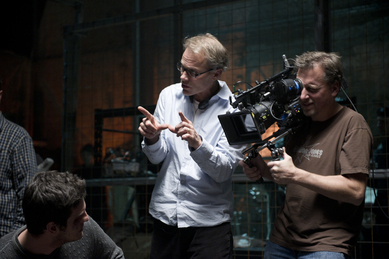____________________________
Many years ago, Mel Brooks appeared on the Johnny Carson show. After the usual riffs and quips, Johnny asked Mel a penetrating question.
“Mel, what do you find to be the hardest thing about making a movie?”
Without hesitation, Mel replied, “Punching in all those little holes along the edges of the film.” Raucous laughter from the live studio audience ensued.
Wouldn’t happen now. These days it would most likely be incomprehension coming from audience members. “Little holes? Huh?”
The fact is that Mel’s once-witty riposte has been rendered irrelevant, meaningless. The explanation is clear, if a touch harsh.
FILM IS OVER! FINISHED! GONE FOREVER! DEAD! AS OUTMODED AS MANUAL TYPEWRITTERS!
The facts are these: Panavision, AARI and Aaton have all quietly ceased production of film cameras. Kodak and Fujifilm are still making film (presumably with the little holes along the sides that Mel referred to back in the day), but Kodak is nearing bankruptcy and Fujifilm isn’t far behind. And what use is a film camera without the film to load into it?
So long celluloid. Hello digital.
But is this a good thing? An improvement? Does anyone care? Are we sad about it … at all?
“Well, I do miss the texture of film,” says David Frazee, director of the two-hour Borealis pilot (for SPACE and CTV) currently in post-production. “But the time has come when using film is just not necessary anymore.”
History has demonstrated that although new technology means certain gains it brings with it certain losses as well. The art of letter writing, for example. Are we to look forward to the collected emails or TWEETS (god forbid!) of our era’s influential thinkers? Never mind. Mr. Frazee sees mostly the positives of digital filming.
“Shooting digital is a lot faster. It’s not like film stock. You don’t have to change loads, which is an advantage,” says the distinguished director who in addition to Borealis has directed multiple episodes of Flashpoint and Endgame, among others. Frazee reports that the newest product from AARI, the “Alexa,” was used by Director of Photography Mathias Herndl to shoot Borealis. “The camera is smaller and lighter, so easier to handle. Also extremely sensitive so you can use less light.” Nor do you need to transfer, or make film prints (which can cost as much as $2000 each) Frazee adds.
So, faithful readers, my blog-foray into the world of technology concludes here, because above is the sum total of what I actually know about it. However, education is ongoing. If you have info, opinions, ideas … please feel free to share. Drop us a line … digitally.
MEDIA-WHEEL

 RSS Feed
RSS Feed